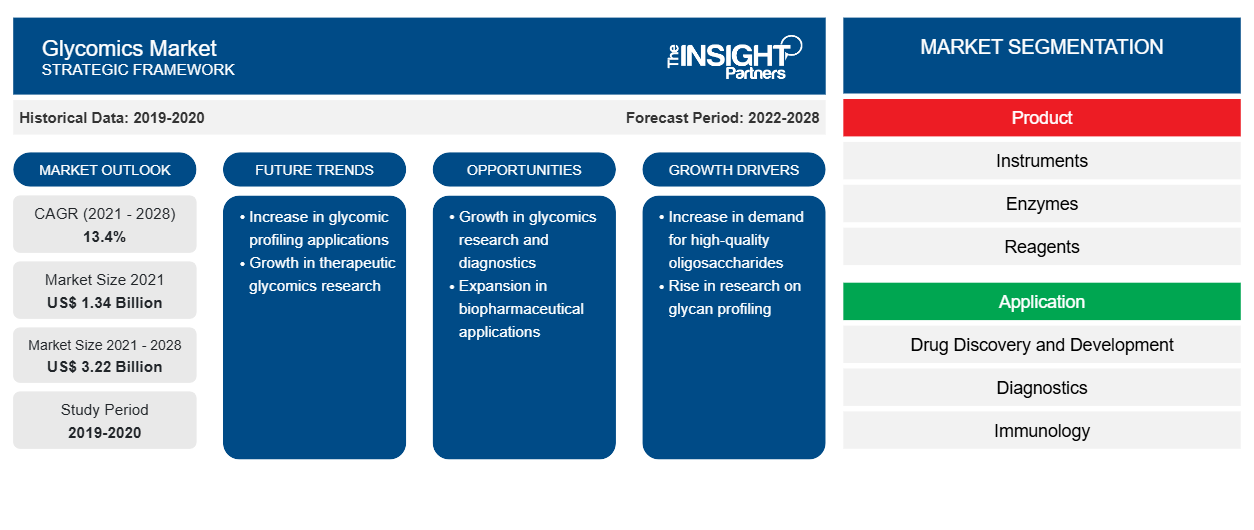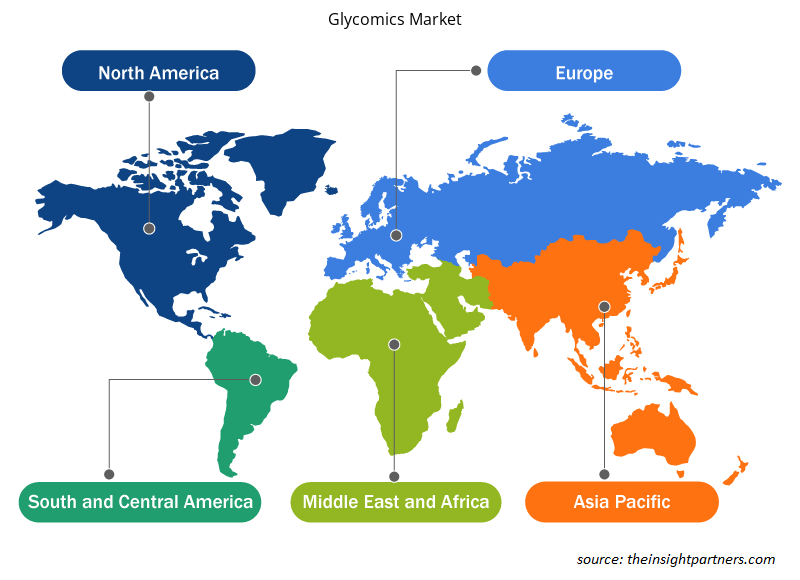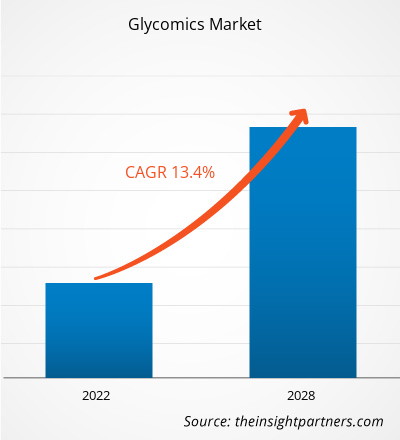[Research Report] The glycomics market is expected to grow from US$ 1,340.80 million in 2021 to US$ 3,223.30 million by 2028; it is estimated to grow at a CAGR of 13.4% from 2022 to 2028.
Glycans are responsible for much of the structural variation in biologic systems, and their representation on cell surfaces is commonly called the “glycome.” Glycomics is an emerging field that aims to focus on the structure and function of glycans in a cell, tissue, or organism. Glycans are chain-like structures of carbohydrates that are free or conjugated to macromolecules such as lipids or proteins. They contribute to a diverse selection of biological processes such as protein folding, cell signaling, and immune recognition. These are implicated in several diseases such as oncological, autoimmune, and others. The glycomics market is being driven by increased glycomics research, a rise in R&D investments, and the use of glycomics to treat various diseases, leading to the development of new treatment processes. However, high equipment costs and a shortage of skilled professionals hinder the overall market growth.
The report offers insights and in-depth analysis of the glycomics market, emphasizing various parameters such as market trends, technological advancements, market dynamics, and competitive landscape analysis of global leading market players. It also includes the impact of the COVID-19 pandemic on the market across all regions. Due to the COVID-19 pandemic, many health authorities focused on pandemic-related care. Recently, more studies on coronavirus have uncovered infection mechanisms that rely on the virus using human glycans. For instance, GlycoNet researchers demonstrated that the COVID-19 virus enters cells by binding to glycolipids. Researchers are now testing whether COVID-19 variants of concern are changing their glycan-binding properties. Thus, the COVID-19 pandemic impacted the glycomics market positively due to the increased research worldwide.
Customize This Report To Suit Your Requirement
You will get customization on any report - free of charge - including parts of this report, or country-level analysis, Excel Data pack, as well as avail great offers and discounts for start-ups & universities
Glycomics Market: Strategic Insights

- Get Top Key Market Trends of this report.This FREE sample will include data analysis, ranging from market trends to estimates and forecasts.
You will get customization on any report - free of charge - including parts of this report, or country-level analysis, Excel Data pack, as well as avail great offers and discounts for start-ups & universities
Glycomics Market: Strategic Insights

- Get Top Key Market Trends of this report.This FREE sample will include data analysis, ranging from market trends to estimates and forecasts.
Geography-Based Insights
By geography, the glycomics market is segmented into North America (US, Canada, and Mexico), Europe (France, Germany, the UK, Spain, Italy, and the Rest of Europe), Asia Pacific (China, India, Japan, Australia, South Korea, and the Rest of APAC), the Middle East & Africa (Saudi Arabia, the UAE, South Africa, and the Rest of the MEA), and South & Central America (Brazil, Argentina, and the Rest of South & Central America).
Market Insights
Rising Use of Glycomics in Various Diseases Leading to Development of New Treatment Processes
As scientists have concentrated their efforts in the glycomics field, they have started to learn important details about the functions of glycans and glycosylation in the body, including cellular communication and what these factors might reveal about disease development and diagnostics. The largest and fastest-growing application category is drug discovery and development, mostly due to the rise in R&D by pharmaceutical and biotechnology firms and the expansion of drug discovery research activities in university research institutions. For instance, in April 2020, to commercialize a cutting-edge cancer detection tool, researchers from the Institute for Glycomics and the University of Adelaide signed an exclusive licensing agreement with Sienna Cancer Diagnostics Ltd. These researchers have created a special protein called SubB2M, which attaches exclusively to a sugar molecule, only found in cancer cells. This protein might revolutionize the detection of cancer. In addition, in January 2022, The National Health and Medical Research Council (NHMRC) gave researchers from the Institute of Glycomics grants totaling more than US$ 1,100,000 million to help them create new medicines to treat multidrug-resistant gonorrhea infections.
Product-Based Insights
Based on product, the global glycomics market is segmented into enzymes, instruments, kits, and reagents. In 2021, the enzymes segment would account for the largest share of the market; it is further expected to register the highest CAGR in the glycomics market from 2022 to 2028.
Application-Based Insights
Based on application, the global glycomics market is segmented into drug discovery and development, diagnostics, immunology, cancer, and others. The drug discovery and development segment would hold the largest share of the market in 2021. However, the diagnostics segment is anticipated to grow at the highest CAGR during the forecast period. The major driving factors for the application segment are increasing research on orphan and rare diseases, rising need for drug development, and growing awareness about early diagnosis.
Glycomics Market Regional Insights
The regional trends and factors influencing the Glycomics Market throughout the forecast period have been thoroughly explained by the analysts at Insight Partners. This section also discusses Glycomics Market segments and geography across North America, Europe, Asia Pacific, Middle East and Africa, and South and Central America.

- Get the Regional Specific Data for Glycomics Market
Glycomics Market Report Scope
| Report Attribute | Details |
|---|---|
| Market size in 2021 | US$ 1.34 Billion |
| Market Size by 2028 | US$ 3.22 Billion |
| Global CAGR (2021 - 2028) | 13.4% |
| Historical Data | 2019-2020 |
| Forecast period | 2022-2028 |
| Segments Covered |
By Product
|
| Regions and Countries Covered | North America
|
| Market leaders and key company profiles |
Glycomics Market Players Density: Understanding Its Impact on Business Dynamics
The Glycomics Market is growing rapidly, driven by increasing end-user demand due to factors such as evolving consumer preferences, technological advancements, and greater awareness of the product's benefits. As demand rises, businesses are expanding their offerings, innovating to meet consumer needs, and capitalizing on emerging trends, which further fuels market growth.
Market players density refers to the distribution of firms or companies operating within a particular market or industry. It indicates how many competitors (market players) are present in a given market space relative to its size or total market value.
Major Companies operating in the Glycomics Market are:
- Merck KGaA
- Agilent Technologies, Inc.
- New England Biolabs
- Thermo Fisher Scientific Inc.
- Waters Corporation
Disclaimer: The companies listed above are not ranked in any particular order.

- Get the Glycomics Market top key players overview
End User-Based Insights
Based on end user, the global glycomics market is segmented into pharmaceutical and biotechnology companies, academic and research institutes, and contract research organizations. The pharmaceutical and biotechnology companies’ segment would hold the largest market share in 2021, and the same segment is expected to grow at the highest CAGR during the forecast period.
The glycomics market players adopt organic strategies such as product launch and expansion to expand their footprint and product portfolio worldwide and meet the growing demand. Some major players contributing to the glycomics market are Merck KGaA; Agilent Technologies, Inc.; New England Biolabs; Thermo Fisher Scientific Inc.; Waters Corporation; Asparia Glycomics; Bruker Corporation; Takara Bio Inc.; S-BIO; and Shimadzu Corporation, among others.
Frequently Asked Questions
What is meant by the Glycomics?
Glycomics is an emerging field that aims to focus on the structure and function of glycans in a cell, tissue, or organism. Glycans are the chain-like structures of carbohydrates that are free or conjugated to macromolecules such as lipids or proteins. They contribute to a diverse selection of biological processes such as protein folding, cell signaling, and immune recognition. These are implicated in several diseases such as oncological, autoimmune, and others.
Which segment led the Glycomics market?
Based on product, the market is segmented into enzymes, instruments, kits, and reagents. The enzymes segment is anticipated to hold the largest share in 2021 and is expected to continue to do so during the forecast period.
Who are the key players in the Glycomics market?
Merck KGaA; Agilent Technologies, Inc.; New England Biolabs; Thermo Fisher Scientific Inc.; Waters Corporation; Asparia Glycomics; Bruker Corporation; Takara Bio Inc.; S-BIO; and Shimadzu Corporation are among the leading companies operating in the global Glycomics market.
- Historical Analysis (2 Years), Base Year, Forecast (7 Years) with CAGR
- PEST and SWOT Analysis
- Market Size Value / Volume - Global, Regional, Country
- Industry and Competitive Landscape
- Excel Dataset
Testimonials
I wish to appreciate your support and the professionalism you displayed in the course of attending to my request for information regarding to infectious disease IVD market in Nigeria. I appreciate your patience, your guidance, and the fact that you were willing to offer a discount, which eventually made it possible for us to close a deal. I look forward to engaging The Insight Partners in the future, all thanks to the impression you have created in me as a result of this first encounter.
DR CHIJIOKE ONYIA, MANAGING DIRECTOR, PineCrest Healthcare Ltd.The Insight Partners delivered insightful, well-structured market research with strong domain expertise. Their team was professional and responsive throughout. The user-friendly website made accessing industry reports seamless. We highly recommend them for reliable, high-quality research services
Yukihiko Adachi CEO, Deep Blue, LLC.Reason to Buy
- Informed Decision-Making
- Understanding Market Dynamics
- Competitive Analysis
- Customer Insights
- Market Forecasts
- Risk Mitigation
- Strategic Planning
- Investment Justification
- Identifying Emerging Markets
- Enhancing Marketing Strategies
- Boosting Operational Efficiency
- Tracking Industry Innovations
- Aligning with Regulatory Trends
Yes! We provide a free sample of the report, which includes Report Scope (Table of Contents), report structure, and selected insights to help you assess the value of the full report. Please click on the "Download Sample" button or contact us to receive your copy.
Absolutely — analyst assistance is part of the package. You can connect with our analyst post-purchase to clarify report insights, methodology or discuss how the findings apply to your business needs.
Once your order is successfully placed, you will receive a confirmation email along with your invoice.
• For published reports: You’ll receive access to the report within 4–6 working hours via a secured email sent to your email.
• For upcoming reports: Your order will be recorded as a pre-booking. Our team will share the estimated release date and keep you informed of any updates. As soon as the report is published, it will be delivered to your registered email.
We offer customization options to align the report with your specific objectives. Whether you need deeper insights into a particular region, industry segment, competitor analysis, or data cut, our research team can tailor the report accordingly. Please share your requirements with us, and we’ll be happy to provide a customized proposal or scope.
The report is available in either PDF format or as an Excel dataset, depending on the license you choose.
The PDF version provides the full analysis and visuals in a ready-to-read format. The Excel dataset includes all underlying data tables for easy manipulation and further analysis.
Please review the license options at checkout or contact us to confirm which formats are included with your purchase.
Our payment process is fully secure and PCI-DSS compliant.
We use trusted and encrypted payment gateways to ensure that all transactions are protected with industry-standard SSL encryption. Your payment details are never stored on our servers and are handled securely by certified third-party processors.
You can make your purchase with confidence, knowing your personal and financial information is safe with us.
Yes, we do offer special pricing for bulk purchases.
If you're interested in purchasing multiple reports, we’re happy to provide a customized bundle offer or volume-based discount tailored to your needs. Please contact our sales team with the list of reports you’re considering, and we’ll share a personalized quote.
Yes, absolutely.
Our team is available to help you make an informed decision. Whether you have questions about the report’s scope, methodology, customization options, or which license suits you best, we’re here to assist. Please reach out to us at sales@theinsightpartners.com, and one of our representatives will get in touch promptly.
Yes, a billing invoice will be automatically generated and sent to your registered email upon successful completion of your purchase.
If you need the invoice in a specific format or require additional details (such as company name, GST, or VAT information), feel free to contact us, and we’ll be happy to assist.
Yes, certainly.
If you encounter any difficulties accessing or receiving your report, our support team is ready to assist you. Simply reach out to us via email or live chat with your order information, and we’ll ensure the issue is resolved quickly so you can access your report without interruption.















The List of Companies - Glycomics Market
- Merck KGaA
- Agilent Technologies, Inc.
- New England Biolabs
- Thermo Fisher Scientific Inc.
- Waters Corporation
- Asparia Glycomics
- Bruker Corporation
- Takara Bio Inc.
- S-BIO
- Shimadzu Corporation






 Get Free Sample For
Get Free Sample For